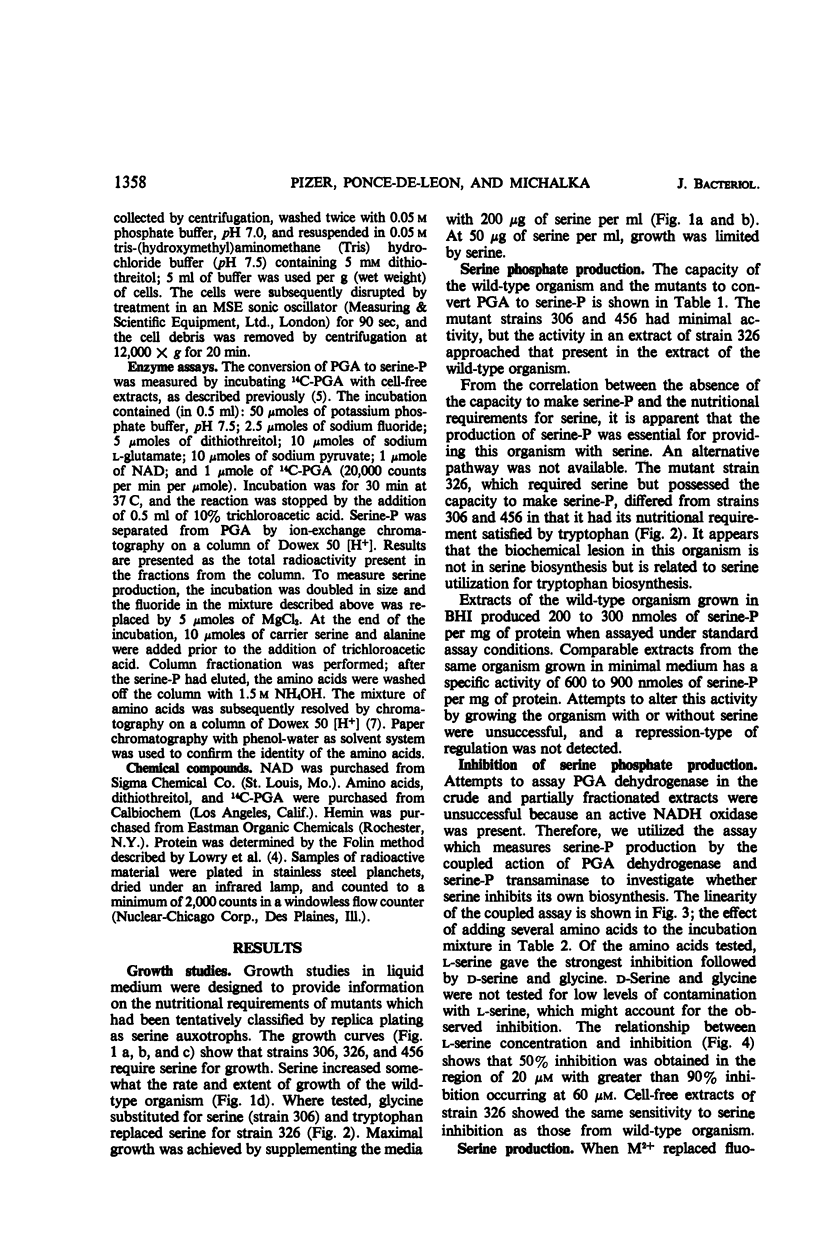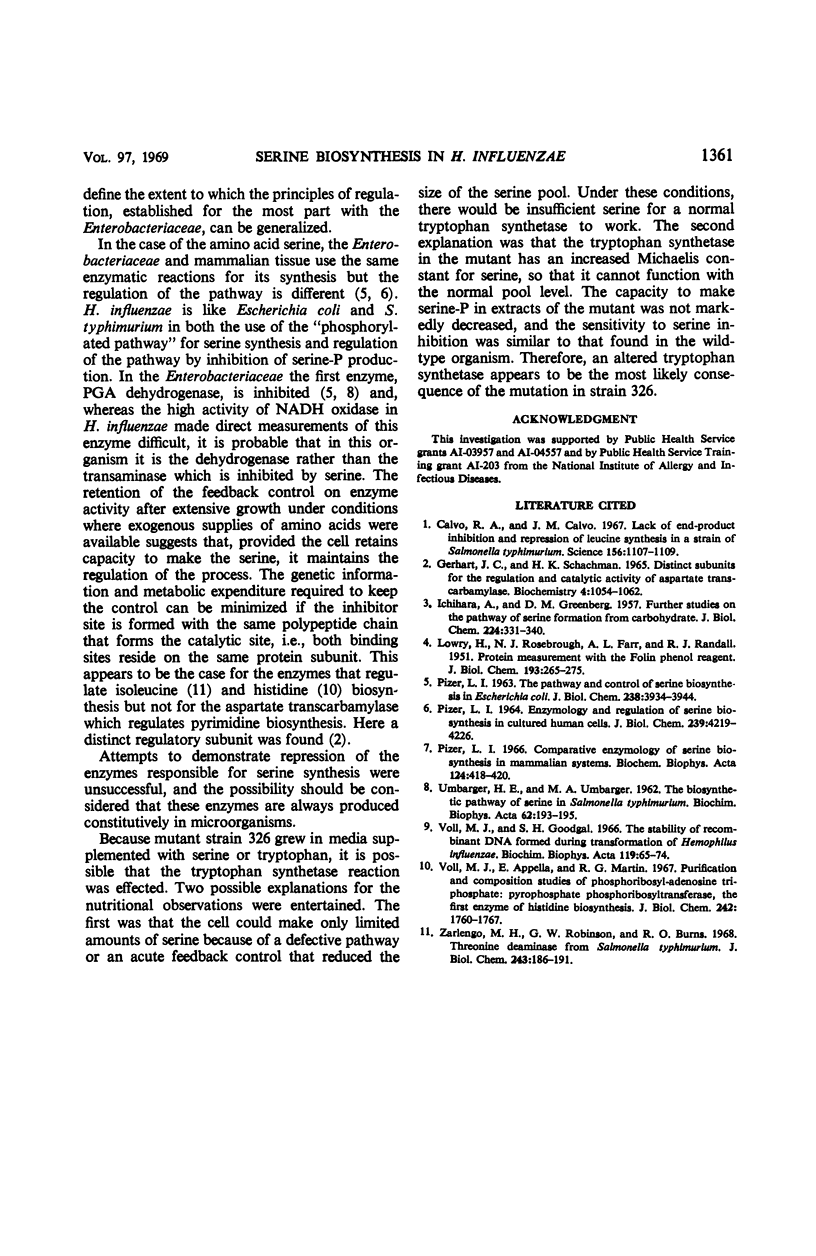Abstract
Nutritional mutants of Haemophilus influenzae requiring l-serine for growth were shown to be deficient in their capacity to synthesize serine-phosphate from 3-phosphoglycerate. On the basis of the correlation between this block and the requirement for an exogenous supply of the amino acid, it was concluded that the “phosphorylated” pathway is the only pathway used by H. influenzae for serine biosynthesis. Serine inhibits serine-phosphate production, thereby regulating its own synthesis in a manner analagous to the Enterobacteriaceae. A mutant strain that required either serine or tryptophan for growth was normal in serine-phosphate synthesis and regulation. It was concluded that this strain probably has a tryptophan synthetase with an increased Michaelis constant for serine.
Full text
PDF




Selected References
These references are in PubMed. This may not be the complete list of references from this article.
- Calvo R. A., Calvo J. M. Lack of end-product inhibition and repression of leucine synthesis in a strain of Salmonella typhimurium. Science. 1967 May 26;156(3778):1107–1109. doi: 10.1126/science.156.3778.1107. [DOI] [PubMed] [Google Scholar]
- GREENBERG D. M., ICHIHARA A. Further studies on the pathway of serine formation from carbohydrate. J Biol Chem. 1957 Jan;224(1):331–340. [PubMed] [Google Scholar]
- Gerhart J. C., Schachman H. K. Distinct subunits for the regulation and catalytic activity of aspartate transcarbamylase. Biochemistry. 1965 Jun;4(6):1054–1062. doi: 10.1021/bi00882a012. [DOI] [PubMed] [Google Scholar]
- LOWRY O. H., ROSEBROUGH N. J., FARR A. L., RANDALL R. J. Protein measurement with the Folin phenol reagent. J Biol Chem. 1951 Nov;193(1):265–275. [PubMed] [Google Scholar]
- PIZER L. I. ENZYMOLOGY AND REGULATION OF SERINE BIOSYNTHESIS IN CULTURED HUMAN CELLS. J Biol Chem. 1964 Dec;239:4219–4226. [PubMed] [Google Scholar]
- PIZER L. I. THE PATHWAY AND CONTROL OF SERINE BIOSYNTHESIS IN ESCHERICHIA COLI. J Biol Chem. 1963 Dec;238:3934–3944. [PubMed] [Google Scholar]
- Pizer L. I. Comparative enzymology of serine biosynthesis in mammalian systems. Biochim Biophys Acta. 1966 Aug 24;124(2):418–420. doi: 10.1016/0304-4165(66)90212-1. [DOI] [PubMed] [Google Scholar]
- UMBARGER H. E., UMBARGER M. A. The biosynthetic pathway of serine in salmonella typhimurium. Biochim Biophys Acta. 1962 Jul 30;62:193–195. doi: 10.1016/0006-3002(62)90515-2. [DOI] [PubMed] [Google Scholar]
- Voll M. J., Appella E., Martin R. G. Purification and composition studies of phosphoribosyladenosine triphosphate:pyrophosphate phosphoribosyltransferase, the first enzyme of histidine biosynthesis. J Biol Chem. 1967 Apr 25;242(8):1760–1767. [PubMed] [Google Scholar]
- Voll M. J., Goodgal S. H. The stability of recombinant DNA formed during transformation of Hemophilus influenzae. Biochim Biophys Acta. 1966 Apr 18;119(1):65–74. doi: 10.1016/0005-2787(66)90038-4. [DOI] [PubMed] [Google Scholar]
- Zarlengo M. H., Robinson G. W., Burns R. O. Threonine deaminase from Salmonella typhimurium. II. The subunit structure. J Biol Chem. 1968 Jan 10;243(1):186–191. [PubMed] [Google Scholar]


